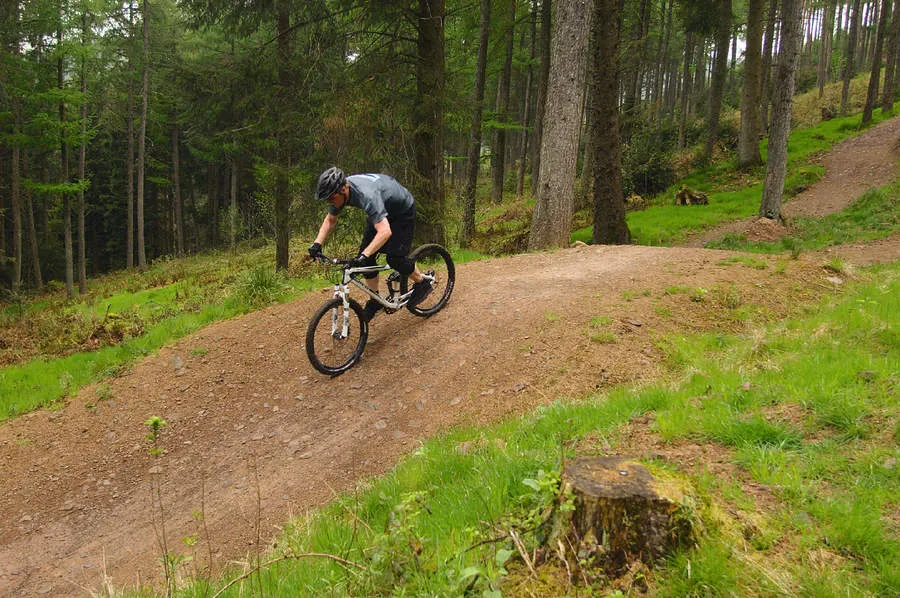There’s nothing to beat the sensation of floating weightless through the air on your bike. While technique is important, the rider must also have supreme confidence in his/her ability for jumping success.
In the last jumping technique article we looked at learning the basics, now we look at advanced jumping techniques.
Step 1: Advanced jumping techniques
Having earned your wings on smaller, more forgiving jumps, it’s now time to move things up a notch to larger table-top style jumps with a defined take-off and separate landing ramp/transition.
This style of jump requires you to fully nose the bike in to the landing to maximise your chances of clearing the jump properly without ‘casing’ the landing. As an added bonus, this gives you the most ‘pump’ or free speed.
- Top tip: Use a quarter-crank turn from the attack position to inject some speed if you’ve misjudged your entry momentum. This allows you to snatch a burst of extra pace while coming out of your optimally balanced position only for a split second.
1] Approach the jump with a brisk jog’s worth of momentum. Once happy with your approach pace, adopt the ‘attack’ position and spot the take-off.

2] Stiffen up into the take-off as before, and allow the front wheel to come up nice and high to give the best chance of clearing the jump.

3] Once your rear wheel comes clear of the take-off, gently level the bike off by moving your weight gently forwards, and pushing down slightly on the bars (never use SPD pedals to do this).

4] Spot the landing and, dependant on the angle, gently nose the bike into transition by pushing gently on the bars. You are aiming to land both wheels together, mirroring the angle of the landing as closely as possible.

5] Aim to pilot the bike back to the floor, rather than slamming the bike into the dirt and losing speed. Once it starts to touch down, immediately allow the bike to come up into your body as you absorb any remaining impact.

6] Rather than slamming the bike into the dirt and losing speed, aim to pilot the bike back to the floor. Once it starts to touch down, immediately allow the bike to come up into your body as you absorb any remaining impact.
Top tips for advanced jumping success
- Be loose and be supremely confident. Mentally shake yourself loose before a jump and practise like hell.
- First, jumping is a blast, and second, if you are dealing with a known quantity you’re less likely to be stiff.
- Start small on table-tops, and work up in scale; doubles can come later once you have nailed the basics.
Step 2: Using hip jumps to change position in the air
Once you’re comfortable on every type of jump in a straight line (short of a double jump), the next step is to look at making a change of direction while in the air. It may sound a tough prospect, but is actually pretty straightforward with the right set-up – and a blast once you have the skill nailed.
1] Spot the start of the jump and start to initiate the turn as you come into the take-off, having decided on the line you want to take out the other side. In this case I am setting up to make a right turn in mid-air so I initiate a gentle right turn as I come into the jump.

2] Try to allow the front wheel to come up nice and high, but as you level off the bike in the air, aim to use your right inside hip as a notional pivot point. Move your body weight around this point, look to your landing and tweak the bars in that direction, too.

3] Spot your landing on the downslope and shift your weight gently forward. Right your body weight again so that you’re centred once more on the bike, and nose it into the landing.

4] Pilot the bike back in to the floor, allowing the bike to come up to your body as you absorb the impact. Look ahead to the next obstacle.
- Top tip: Is it better to use a full-suspension bike or a hardtail for jumping? Hardtails give you more pump and air time for less work, but are less forgiving of duff technique. Bikes with rear suspension will suck more up the jumps, but are more forgiving in terms of technique and help you manage landings.
Set-up tips: How you can tackle jumps more easily

Flat pedals are a must: they promote good technique/ confidence (essential for jumping), and give you the option to bail out should the worst happen.

Helmets are also an essential when jumping, and if you are planning on jumping big then consider a full-face helmet. This is a Troy Lee D2 Carbon.

Knees are pretty fragile, and any protection you can give them is good. Try to remember you are not supposed to be crashing in the first place, though!
About the coach

David Webster has used his wealth of riding experience in MTB, BMX, downhill, road and trials riding to identify core trail riding skills. He has developed an extremely effective way of teaching them at his sell-out Transcend MTB skills courses based mainly at Glentress Forest, the Scottish Borders, Sherwood Pines, Notts and Dalby Forest and North Yorkshire.
Calling upon some 20 years’ riding experience complemented by SMBLA and British Cycling level 2 training and qualifi cations, David has a proven record of helping riders develop a more skilful and smooth riding style. Both novice and experienced riders of all ages and riding backgrounds have benefited greatly. Visit www.transcendtrailacademy.com for more details. Transcend is proud to be supported by Trek, Gore Bike Wear and Dakine.